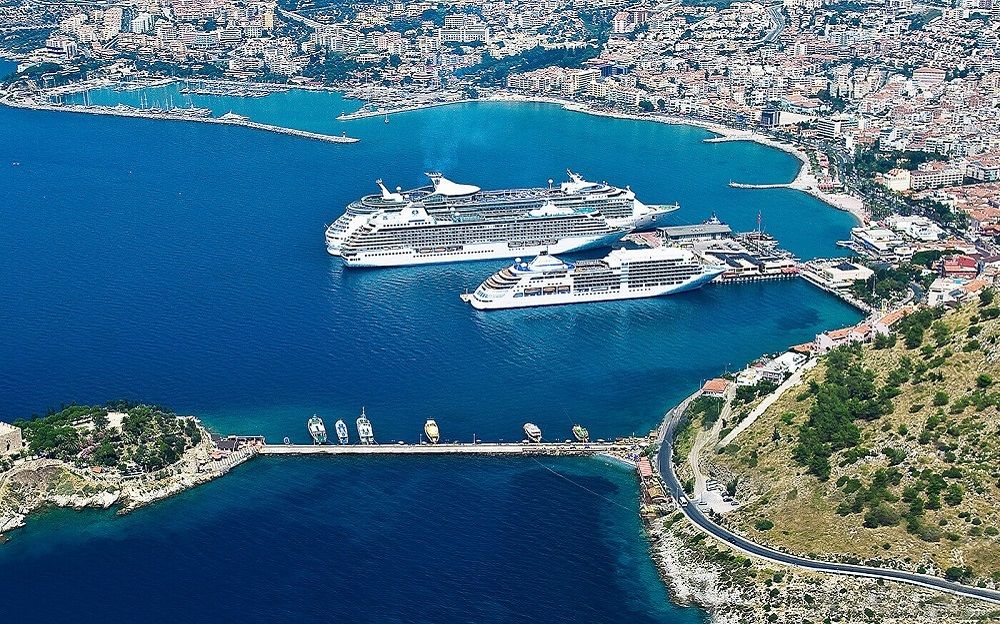Home > Excursions > Kusadasi > Kusadasi Area

Kusadasi
Tours Activities

Pigeon island in KusadasiKusadasi, which means "bird island", is set in a superb gulf in the Aegean region of Turkey and is known for its turquoise sparkling water of the Sea, broad sandy beaches, bright sun and large marina with a capacity for 600 boats. A glorious ancient city stands beside it, Ephesus with hundreds of thousands of visitors from tours each year. The town is not far from Adnan Menderes Airport, Izmir (only 80 kilometers or 50 miles). Numerous holiday villages and hotels line its shores and hundreds of restaurants serves food from all around the world and, of course, Turkish Cuisine, which is one of the largest cuisines of the world. There are also many hostels, discos, bars, cafes, pubs and "Turkish Nights"; all those to cater holiday-makers.
Kusadasi has retained a certain earthiness to it and inexpensive meals and pensions can still be found in town. Many shops do a brisk trade with passengers from hundreds of cruise ships that dock for a day or two, allowing enough time for a trip to Ephesus and a shopping expedition.
The tiny Güvercin Adasi (Pigeon Island) is connected to the mainland with a causeway. Its romantic setting includes a well-maintained flower garden which surrounds the restored 14th or 15th century fortress housing a restaurant and disco frequented by lovers or those hoping to find one by the night's end.
Beaches close to town tend to get quite crowded during summer. If you prefer more serenity, head for Dilek Peninsula National Park, known locally as Milli Park about 28 km (17 miles) from Kusadasi.
It is also possible to get to Greek island Samos by regular daily ferries.
Lately, many foreigners have bought (and continue to buy) property in and around Kusadasi for their holidays or for the retirement. It became a popular area especially for the British and Irish nationals.
History
Around 2000 BC. people coming from Lelek, Caria and Lydia had settled down as a society to the slopes of Pilav Mountain. Later one by one with the unit settlements Pigale, Maratheson, Neopolis and Panionion came to life; Ionians and later Romans by Ephesus coming into the dominance of Rome, had lived in these lands.
Today's Kusadasi is founded in 16th century by Venetians as a colony. The castle on the small island was built for the purpose of observation in Byzantine times. In the Middle Ages Kusadasi was ruled by Venetians and Genoese which had taken the name of Scala Nova.
The city was surrounded with castle walls for being protected from the violence of pirates, very common in the Mediterranean those centuries. It's known that there is an Ionian Region of Kusadasi. This had taken an important harbor mission on Asia - Europe trade road for many years.
In the period of Scala Nova, the Armenians dominant to trade, Greeks and Jews had joined to former nations. With the Manzikert (Malazgirt) War in 1071 Seljuk Turks had started to spread in Anatolia and during the process of Turkish principalities formation, in 1304 Sasa Bey had been the authority of Kusadasi and surroundings. Mehmet Bey had connected this vicinity to Aydinogullari after Sasa's death.
Kusadasi is a harbor town and Turks had kept this in mind. Although they were nomads from central Asia and far away from maritime business, they had learnt maritime as well as the Ephesians in a short time. They had lived comfortably with the spoils they caught at naval battles. Kilic Arslan added this town to Selcuk government and Scala Nova again had become the exportation gate of Anatolia in 1186. The Ottoman sultan Yildirim Beyazit had joined Ayasulug (in Selcuk town) to his principalities and the city became Ottoman in 1390. Tamerlane (Timurlenk) decided to take whole of Anatolia under his sovereign, but when he could not take Ayasulug he put the castle on fire in which Ottoman soldiers resisted, and St. Jean's Church was damaged very badly. With Çelebi Mehmet I Kusadasi had gathered to the Ottoman Empire and became a district.
With the vicinities passing to Ottomans, Turks entered into societies in these areas. At the end of 1st World War Ottoman Government had overcome, so Kusadasi was given to Italians with a treaty, and under their rule, the town was filled with Turks, Greeks, Jews, Armenians. Most of those minorities left the country on 7th September 1923 after the victory of War of Independence led by Atatürk. Lands between Güzelcamli and Selcuk, the estates of Greeks which went back during the agreement to exchange minorities between Greece and Turkey, were given to Turkish immigrants in return to their properties there; the same was done by the Greek government. This migration was between 1941 and 1955.
Kusadasi is living parallel to Ephesus in history and the settlements around it. The places that have historical and tourist values are:
Panionian Agora, Roman Bath, Ilica Hill, Scala Nova, Pygale, Kadi Castle, Andiz Tower, Neopolis, Aquaducts, Ania, Melia, Kursunlu Monastery, Öküz Mehmet Pasha Caravanserai, The Castle on Pigeon Island, Ramparts surrounding the City, Kusadasi Houses, Kaleici, Mosques, Turkish Baths, Yacht Harbor and Dilek National Park.
Get infoKemeralti Mahallesi, Kemeralti 64 sokak No:2B MARMARIS
Tel: +90 252 413 46 01
Gsm: +90 544 455 00 06 - +90 0552 490 10 44
info@arbektravel.com